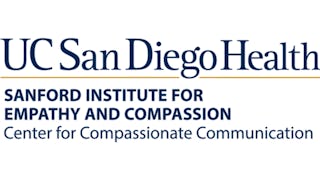Public health communicators have a duty to communicate health information with integrity, accuracy, and clarity. For messaging to be most effective, public health communicators must help their audiences draw meaningful connections with the information being shared, and connect with them in ways that foster trust and credibility.

Enjoy unlimited growth with a year of Coursera Plus for $199 (regularly $399). Save now.

Connect with Diverse Audiences during a Public Health Crisis
This course is part of Leadership for Public Health Crises Specialization

Instructor: Brenda Hoffman, Ph.D.
1,971 already enrolled
Included with
(28 reviews)
Recommended experience
Skills you'll gain
Details to know

Add to your LinkedIn profile
See how employees at top companies are mastering in-demand skills

Build your subject-matter expertise
- Learn new concepts from industry experts
- Gain a foundational understanding of a subject or tool
- Develop job-relevant skills with hands-on projects
- Earn a shareable career certificate

There are 4 modules in this course
People's culture, history, and lived experiences affect how they interpret and engage with health-risk information. Without acknowledging these influences, public health communicators may struggle to successfully engage their audiences with the information at hand. This module explores how public health communicators can segment their audiences into smaller groups, thereby allowing them to tailor messages to each group's unique needs.
What's included
4 videos5 readings4 assignments1 peer review
To motivate people to act on health information, public health communicators must be able to make that information relevant to their audiences, and connect with them in ways that foster trust and credibility. One way to connect with audiences is through empathy. Taking the time to understand where they are coming from, and acknowledging their perspectives regardless of the accuracy of those perspectives, shows people that you care. This module explores how public health communicators can recognize and overcome underlying biases, assumptions, and stereotypes to create messaging that is rooted in empathy.
What's included
4 videos5 readings4 assignments1 peer review1 discussion prompt
Whether public health messages are successful at motivating people to adopt a recommended action, is driven largely by the person or entity communicating that information, and the structural components of the message itself. This module explores how public health communicators can leverage persuasive communication strategies, to frame and deliver their messages in ways that appeal to their audience’s core values.
What's included
3 videos4 readings3 assignments1 peer review1 discussion prompt
For some audiences, a media interview is the only channel through which they will encounter important health and safety information during a public health crisis. During an interview, public health communicators must convey high stakes information in a short amount of time, connect with the viewers, and convince them to adopt actionable steps to protect themselves. This module explores how public health communicators can approach media interviews with confidence, and shift their attention outward with a greater focus on their audience(s).
What's included
3 videos2 readings3 assignments1 peer review1 discussion prompt
Earn a career certificate
Add this credential to your LinkedIn profile, resume, or CV. Share it on social media and in your performance review.
Instructor

Offered by
Explore more from Leadership and Management
 Status: Free Trial
Status: Free TrialUniversity of Minnesota
 Status: Preview
Status: PreviewUniversity of California San Diego
 Status: Free Trial
Status: Free TrialThe State University of New York
 Status: Preview
Status: PreviewUniversity of Michigan
Why people choose Coursera for their career




Frequently asked questions
To access the course materials, assignments and to earn a Certificate, you will need to purchase the Certificate experience when you enroll in a course. You can try a Free Trial instead, or apply for Financial Aid. The course may offer 'Full Course, No Certificate' instead. This option lets you see all course materials, submit required assessments, and get a final grade. This also means that you will not be able to purchase a Certificate experience.
When you enroll in the course, you get access to all of the courses in the Specialization, and you earn a certificate when you complete the work. Your electronic Certificate will be added to your Accomplishments page - from there, you can print your Certificate or add it to your LinkedIn profile.
Yes. In select learning programs, you can apply for financial aid or a scholarship if you can’t afford the enrollment fee. If fin aid or scholarship is available for your learning program selection, you’ll find a link to apply on the description page.
More questions
Financial aid available,
¹ Some assignments in this course are AI-graded. For these assignments, your data will be used in accordance with Coursera's Privacy Notice.





